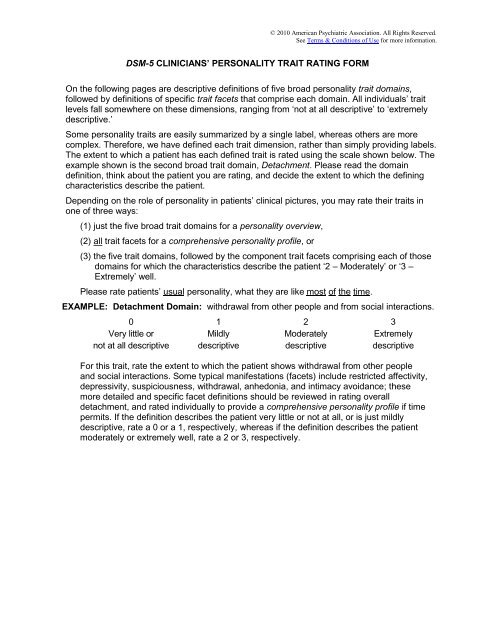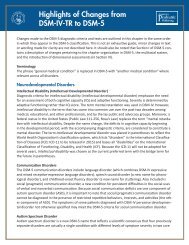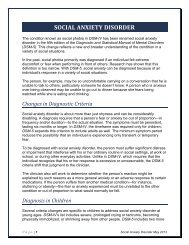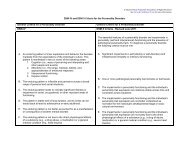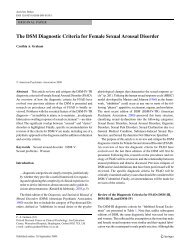DSM-5 CLINICIANS' PERSONALITY TRAIT RATING FORM On the ...
DSM-5 CLINICIANS' PERSONALITY TRAIT RATING FORM On the ...
DSM-5 CLINICIANS' PERSONALITY TRAIT RATING FORM On the ...
You also want an ePaper? Increase the reach of your titles
YUMPU automatically turns print PDFs into web optimized ePapers that Google loves.
© 2010 American Psychiatric Association. All Rights Reserved.<br />
See Terms & Conditions of Use for more information.<br />
<strong>DSM</strong>-5 CLINICIANS’ <strong>PERSONALITY</strong> <strong>TRAIT</strong> <strong>RATING</strong> <strong>FORM</strong><br />
<strong>On</strong> <strong>the</strong> following pages are descriptive definitions of five broad personality trait domains,<br />
followed by definitions of specific trait facets that comprise each domain. All individuals’ trait<br />
levels fall somewhere on <strong>the</strong>se dimensions, ranging from ‘not at all descriptive’ to ‘extremely<br />
descriptive.’<br />
Some personality traits are easily summarized by a single label, whereas o<strong>the</strong>rs are more<br />
complex. Therefore, we have defined each trait dimension, ra<strong>the</strong>r than simply providing labels.<br />
The extent to which a patient has each defined trait is rated using <strong>the</strong> scale shown below. The<br />
example shown is <strong>the</strong> second broad trait domain, Detachment. Please read <strong>the</strong> domain<br />
definition, think about <strong>the</strong> patient you are rating, and decide <strong>the</strong> extent to which <strong>the</strong> defining<br />
characteristics describe <strong>the</strong> patient.<br />
Depending on <strong>the</strong> role of personality in patients’ clinical pictures, you may rate <strong>the</strong>ir traits in<br />
one of three ways:<br />
(1) just <strong>the</strong> five broad trait domains for a personality overview,<br />
(2) all trait facets for a comprehensive personality profile, or<br />
(3) <strong>the</strong> five trait domains, followed by <strong>the</strong> component trait facets comprising each of those<br />
domains for which <strong>the</strong> characteristics describe <strong>the</strong> patient ‘2 – Moderately’ or ‘3 –<br />
Extremely’ well.<br />
Please rate patients’ usual personality, what <strong>the</strong>y are like most of <strong>the</strong> time.<br />
EXAMPLE: Detachment Domain: withdrawal from o<strong>the</strong>r people and from social interactions.<br />
0 1 2 3<br />
Very little or Mildly Moderately Extremely<br />
not at all descriptive descriptive descriptive descriptive<br />
For this trait, rate <strong>the</strong> extent to which <strong>the</strong> patient shows withdrawal from o<strong>the</strong>r people<br />
and social interactions. Some typical manifestations (facets) include restricted affectivity,<br />
depressivity, suspiciousness, withdrawal, anhedonia, and intimacy avoidance; <strong>the</strong>se<br />
more detailed and specific facet definitions should be reviewed in rating overall<br />
detachment, and rated individually to provide a comprehensive personality profile if time<br />
permits. If <strong>the</strong> definition describes <strong>the</strong> patient very little or not at all, or is just mildly<br />
descriptive, rate a 0 or a 1, respectively, whereas if <strong>the</strong> definition describes <strong>the</strong> patient<br />
moderately or extremely well, rate a 2 or 3, respectively.
Personality Overview<br />
© 2010 American Psychiatric Association. All Rights Reserved.<br />
See Terms & Conditions of Use for more information.<br />
The five trait domains and <strong>the</strong> specific trait facets comprising <strong>the</strong> domains follow. Please<br />
review <strong>the</strong> more detailed and specific facet definitions in rating overall trait domains, and<br />
complete a comprehensive personality profile if time permits.<br />
0 1 2 3<br />
Very little or Mildly Moderately Extremely<br />
not at all descriptive descriptive descriptive descriptive<br />
_______ Negative Affectivity Experiences negative emotions frequently and intensely<br />
Trait facets: Emotional lability, anxiousness, separation insecurity,<br />
perseveration, submissiveness, hostility, depressivity,<br />
suspiciousness, (lack of) restricted affectivity<br />
________ Detachment Withdrawal from o<strong>the</strong>r people and from social interactions.<br />
Trait facets: Restricted affectivity, depressivity, suspiciousness,<br />
withdrawal, anhedonia, intimacy avoidance,<br />
________ Antagonism Engaging in behaviors that put <strong>the</strong> person at odds with<br />
o<strong>the</strong>r people.<br />
Trait facets: Manipulativeness, deceitfulness, grandiosity, attention<br />
seeking, callousness, hostility<br />
________ Disinhibition Engaging in behaviors on impulse, without reflecting on<br />
potential future consequences.<br />
NOTE: Compulsivity is <strong>the</strong> opposite of disinhibition and, if<br />
present, should be recorded at <strong>the</strong> facet level as rigid<br />
perfectionism in <strong>the</strong> absence of o<strong>the</strong>r disinhibition facets.<br />
Trait facets: Irresponsibility, impulsivity, distractibility, risk taking, (lack<br />
of) rigid perfectionism<br />
________ Psychoticism Unusual and bizarre experiences<br />
Trait facets: Unusual beliefs & experiences, eccentricity, cognitive &<br />
perceptual dysregulation
Comprehensive Personality Profile<br />
The twenty-five specific trait facets comprising <strong>the</strong> five domains follow.<br />
© 2010 American Psychiatric Association. All Rights Reserved.<br />
See Terms & Conditions of Use for more information.<br />
0 1 2 3<br />
Very little or Mildly Moderately Extremely<br />
not at all descriptive descriptive descriptive descriptive<br />
Negative Affectivity: experiences negative emotions frequently and intensely<br />
NOTE: Restricted affectivity is listed under <strong>the</strong> Detachment heading, but <strong>the</strong> absence of this facet trait – i.e., a<br />
tendency to have strong reactions to emotionally arousing situations, should also be evaluated in rating <strong>the</strong> overall<br />
Negative Affectivity domain<br />
________ Emotional lability Unstable emotional experiences and frequent mood changes;<br />
emotions that are easily aroused, intense, and/or out of<br />
proportion to events and circumstances.<br />
________ Anxiousness Intense feelings of nervousness, tenseness, or panic in<br />
reaction to diverse situations; worry about <strong>the</strong> negative effects<br />
of past unpleasant experiences and future negative<br />
possibilities; feeling fearful, apprehensive, or threatened by<br />
uncertainty; fears of falling apart, losing control, or<br />
embarrassment.<br />
________ Separation insecurity Fears of rejection by – and/or separation from – significant<br />
o<strong>the</strong>rs, associated with fears of excessive dependency and<br />
complete loss of autonomy.<br />
________ Perseveration Persistence at tasks long after <strong>the</strong> behavior has ceased to be<br />
functional or effective; continuance of <strong>the</strong> same behavior<br />
despite repeated failures.<br />
________ Submissiveness Adaptation of one’s behavior to <strong>the</strong> interests and desires of<br />
o<strong>the</strong>rs<br />
________ Hostility Persistent or frequent angry feelings; anger or irritability in<br />
response to minor slights and insults; mean, nasty, or vengeful<br />
behavior.<br />
________ Depressivity Frequent feelings of being down, miserable, and/or hopeless;<br />
difficulty recovering from such moods; pessimism about <strong>the</strong><br />
future; pervasive shame; feelings of inferior self worth;<br />
thoughts of suicide and suicidal behavior.<br />
________ Suspiciousness Expectations of -- and heightened sensitivity to -- signs of<br />
interpersonal ill-intent or harm; doubts about loyalty and fidelity<br />
of o<strong>the</strong>rs; feelings of persecution
Detachment: withdrawal from o<strong>the</strong>r people and from social interactions.<br />
© 2010 American Psychiatric Association. All Rights Reserved.<br />
See Terms & Conditions of Use for more information.<br />
NOTE: Because <strong>the</strong>y are rated earlier, as part of Negative Affectivity, Depressivity and Suspiciousness are not listed<br />
again under <strong>the</strong> Detachment heading, but should be evaluated in rating <strong>the</strong> overall Detachment domain<br />
________ Restricted affectivity Little reaction to emotionally arousing situations;<br />
constricted emotional experience and expression; indifference<br />
or coldness.<br />
________ Withdrawal Preference for being alone to being with o<strong>the</strong>rs; reticence in<br />
social situations; avoidance of social contacts and activity; lack<br />
of initiation of social contact.<br />
________ Anhedonia Lack of enjoyment from, engagement in, or energy for life‘s<br />
experiences; deficits in <strong>the</strong> capacity to feel pleasure or take<br />
interest in things.<br />
________ Intimacy avoidance Avoidance of close or romantic relationships, interpersonal<br />
attachments, and intimate sexual relationships.
© 2010 American Psychiatric Association. All Rights Reserved.<br />
See Terms & Conditions of Use for more information.<br />
Antagonism: engaging in behaviors that put <strong>the</strong> person at odds with o<strong>the</strong>r people<br />
NOTE: Because it is rated earlier, as part of Negative Affectivity, Hostility is not listed again under <strong>the</strong> Antagonism<br />
heading, but should be evaluated in rating <strong>the</strong> overall Antagonism domain<br />
________ Manipulativeness Frequent use of subterfuge to influence or control o<strong>the</strong>rs; use<br />
of seduction, charm, glibness, or ingratiation to achieve one‘s<br />
ends.<br />
________ Deceitfulness Dishonesty and fraudulence; misrepresentation of self;<br />
embellishment or fabrication when relating events.<br />
________ Grandiosity Feelings of entitlement, ei<strong>the</strong>r overt or covert; selfcenteredness;<br />
firmly holding to <strong>the</strong> belief that one is better<br />
than o<strong>the</strong>rs; condescending toward o<strong>the</strong>rs.<br />
________ Attention seeking Excessive attempts to attract and be <strong>the</strong> focus of <strong>the</strong> attention<br />
of o<strong>the</strong>rs; admiration seeking.<br />
________ Callousness Lack of concern for feelings or problems of o<strong>the</strong>rs; lack of guilt or<br />
remorse about <strong>the</strong> negative or harmful effects of one‘s actions on<br />
o<strong>the</strong>rs; aggression; sadism.
© 2010 American Psychiatric Association. All Rights Reserved.<br />
See Terms & Conditions of Use for more information.<br />
Disinhibition: engaging in behaviors on impulse, without reflecting on potential future<br />
consequences.<br />
NOTE: Compulsivity is <strong>the</strong> opposite of disinhibition and, if present, should be recorded at <strong>the</strong> facet level as rigid<br />
perfectionism in <strong>the</strong> absence of o<strong>the</strong>r disinhibition facets.<br />
________ Irresponsibility Disregard for – and failure to honor – financial and o<strong>the</strong>r<br />
obligations or commitments; lack of respect for – and lack of<br />
follow through on – agreements and promises.<br />
________ Impulsivity Acting on <strong>the</strong> spur of <strong>the</strong> moment in response to immediate<br />
stimuli; acting on a momentary basis without a plan or<br />
consideration of outcomes; difficulty establishing and following<br />
plans; a sense of urgency and self-harming behavior under<br />
emotional distress<br />
________ Distractibility Difficulty concentrating and focusing on tasks; attention is<br />
easily diverted by extraneous stimuli; difficulty maintaining<br />
goal-focused behavior.<br />
________ Risk taking Engagement in dangerous, risky, and potentially selfdamaging<br />
activities, unnecessarily and without regard to<br />
consequences; boredom proneness and thoughtless initiation<br />
of activities to counter boredom; lack of concern for one’s<br />
limitations and denial of <strong>the</strong> reality of personal danger<br />
________ (lack of) Rigid<br />
perfectionism Rigid insistence on everything being flawless, perfect, without<br />
errors or faults, including one‘s own and o<strong>the</strong>rs‘ performance;<br />
sacrificing of timeliness to ensure correctness in every detail;<br />
believing that <strong>the</strong>re is only one right way to do things; difficulty<br />
changing ideas and/or viewpoint; preoccupation with details,<br />
organization, and order.<br />
NOTE: Rigid Perfectionism reflects Compulsivity, which is <strong>the</strong> opposite of<br />
disinhibition and is <strong>the</strong>refore located in <strong>the</strong> disinhibition domain. If present,<br />
compulsivity should be recorded at <strong>the</strong> facet level as a higher rigid<br />
perfectionism score accompanied by lower scores on o<strong>the</strong>r disinhibition<br />
facets.
Psychoticism: unusual and bizarre experiences<br />
© 2010 American Psychiatric Association. All Rights Reserved.<br />
See Terms & Conditions of Use for more information.<br />
________ Unusual beliefs Thought content that is viewed by o<strong>the</strong>rs as<br />
and experiences bizarre or idiosyncratic, unusual experiences of reality.<br />
________ Eccentricity Odd, unusual, or bizarre behavior or appearance; saying<br />
unusual or inappropriate things.<br />
________ Cognitive and Odd or unusual thought processes; vague, circumstantial,<br />
Perceptual metaphorical, over-elaborate, or stereotyped thought or<br />
dysregulation speech; odd experiences in various sensory modalities.


